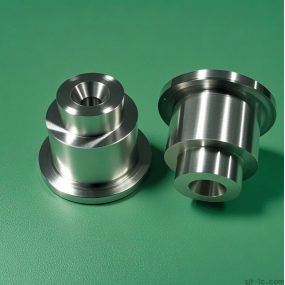Turning is mainly carried out on lathes, using cutting tools to cut rotating workpieces. On the lathe, corresponding machining can also be carried out using drill bits, reaming drills, reamers, taps, dies, and rolling tools. The machining principle of turning is: the workpiece rotates (main motion), and the turning tool moves in a straight or curved line in a plane (feed motion), which can be used to machine inner and outer cylindrical surfaces, end faces, conical surfaces, forming surfaces, and threads. When turning cylindrical surfaces, the turning tool moves in a direction parallel to the axis of rotation of the workpiece; When turning end faces or cutting workpieces, the turning tool moves horizontally in a direction perpendicular to the axis of rotation of the workpiece. If the direction of motion of the turning tool is at an oblique angle to the axis of rotation of the workpiece, it can be machined into a conical surface.
 Precautions for turning operation:
Precautions for turning operation:
(1) Before starting work, lubricate the lathe and check if the handle is in place. Run the lathe slowly for 5 minutes to confirm everything is normal before operation;
(2) The chuck clamp needs to be worn, and the wrench cannot be left on it;
(3) The workpiece and cutting tool should be securely clamped, and the tool holder should not extend too long (except for boring holes). When rotating the small tool holder, it should be stopped to prevent the tool from colliding with the chuck, workpiece, or cutting the hand;
(4) When the workpiece is running, people should not stand directly in front of it, not lean against the lathe, and not step on the oil pan with their feet;
(5) To ensure safety during high-speed cutting, a cutting tool and a gear screen should be used;
(6) Prohibit high-speed reverse braking, and ensure smooth exiting and parking;
(7) When removing iron filings, a brush or specialized hook should be used;
(8) When using a file to polish the workpiece, the right hand must be in front and the left hand behind; When using gauze to polish the workpiece, tools such as hand clamps should be used to prevent twisting injuries;
(9) All reused tools, measuring instruments, and cutting tools must be placed in a nearby safe location and kept neat and orderly;
(10) When removing or measuring workpieces at the front of the vehicle, wait for the lathe to come to a complete stop before operating;
(11) When the lathe is working, it is forbidden to open or remove the protective device;
(12) As work approaches, the lathe should be cleaned and wiped, and the tailstock and slide box should be moved back to the rightmost end of the lathe bed.
The main parameters of turning machining are the back cutting amount and feed rate. The back cutting amount refers to the maximum size of the cutting layer perpendicular to the feed rate direction, generally referring to the vertical distance between the machined surface and the surface to be machined on the workpiece. Feed rate refers to the relative displacement of the workpiece (or tool) in the direction of feed motion for each rotation or reciprocating motion of the workpiece (or tool), or for each tooth rotated by the tool. During rough machining, try to use a larger back cutting and feed rate to improve productivity, while during fine machining, choose a smaller back cutting and feed rate to ensure the required machining accuracy and surface quality of the workpiece.


 Spanish
Spanish Arabic
Arabic French
French Portuguese
Portuguese Belarusian
Belarusian Japanese
Japanese Russian
Russian Malay
Malay Icelandic
Icelandic Bulgarian
Bulgarian Azerbaijani
Azerbaijani Estonian
Estonian Irish
Irish Polish
Polish Persian
Persian Boolean
Boolean Danish
Danish German
German Filipino
Filipino Finnish
Finnish Korean
Korean Dutch
Dutch Galician
Galician Catalan
Catalan Czech
Czech Croatian
Croatian Latin
Latin Latvian
Latvian Romanian
Romanian Maltese
Maltese Macedonian
Macedonian Norwegian
Norwegian Swedish
Swedish Serbian
Serbian Slovak
Slovak Slovenian
Slovenian Swahili
Swahili Thai
Thai Turkish
Turkish Welsh
Welsh Urdu
Urdu Ukrainian
Ukrainian Greek
Greek Hungarian
Hungarian Italian
Italian Yiddish
Yiddish Indonesian
Indonesian Vietnamese
Vietnamese Haitian Creole
Haitian Creole Spanish Basque
Spanish Basque










